
May 29, 2023
Recently, after more than 100 years of tenancy, our Dunedin office has shut its doors and migrated. The office building on the corner of Bond, Water and Crawford streets has been the address of the Dunedin branch of the company since approximately 1906. Although the building bears our name, however, it has not always been our home.
This blog post will be exploring a little of the legacy and history of this building which, although our tenancy has concluded, will hopefully remain a part of the Dunedin landscape for years to come.
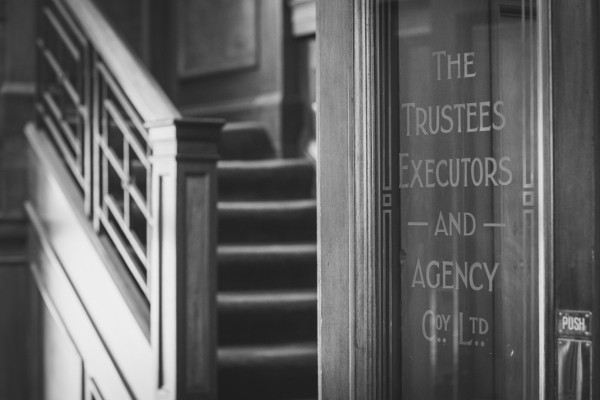
Throughout its 142 years of operation, Trustees Executors has been intrinsically linked to the city of Dunedin. The mid-to-late 19th century was the boom era for Dunedin; wealth flowed from the Otago goldfields, and the city was rife with opportunity for keen minded businessmen. Many well-known New Zealand companies were founded here at this time, such as Speights and Greggs (and, it should go without saying, Trustees Executors).
In the earliest years of the company – from 1881 until about 1905 – information about the physical location of the offices is vague. It seems likely that the company offices were on Princes Street, although the exact address has so far proved elusive. These minutes from 1881 helpfully state that a meeting was held ‘at the Companies’ office’. No further information was forthcoming!
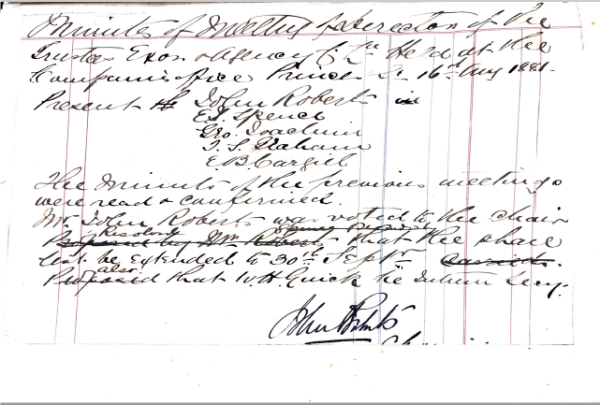
Notes from the Minute Book of the company, May 1881.
Minute book, Hocken Library, 84-203, Box 1.
In the 19th century and into the 20th, Princes and Bond Streets were the financial epicentre of Dunedin. Initially little more than a dirt road in a remote colonial settlement, the gold rush in Otago in the 1860s which heralded the transformation of Dunedin into the powerhouse of the 19th century New Zealand economy would also see the transformation of Princes street.
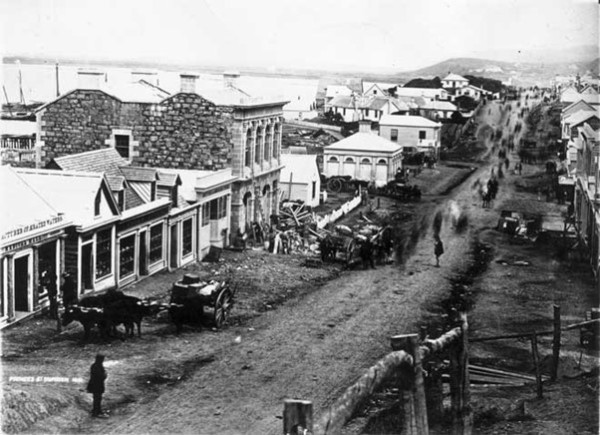
Princes Street, 1861.
David Thorns and Ben Schrader, 'City history and people - Towns to cities', Te Ara - the Encyclopedia of New Zealand, http://www.TeAra.govt.nz/en/photograph/23503/princes-street-dunedin-1861 (accessed 26 April 2023)
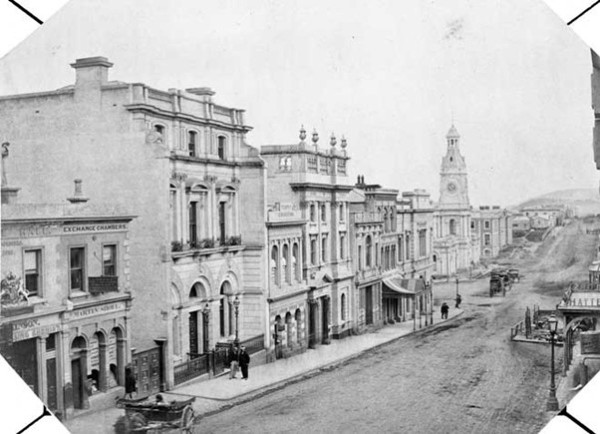
Princes Street approx. 1870, a decade before Trustees Executors was founded.
David Thorns and Ben Schrader, 'City history and people - Towns to cities', Te Ara - the Encyclopedia of New Zealand, http://www.TeAra.govt.nz/en/photograph/23504/princes-street-dunedin-around-1870 (accessed 26 April 2023)
Bond Street is described by historian Erik Olssen as being, c. the 1860s, the “heart of the city’s business district.” This area of Dunedin was simultaneously the financial and the warehouse district, and unsurprisingly was to become the home of almost every one of the businesses founded in this era:
“There is a good reason why so many businesses, essentially performing different functions within the same trade, were located cheek by jowl in this way: there was no better way of freely discussing ideas than by face-to-face contact, even after telephones were widely adopted in the 1880s. Through this process of ‘nourishing and fostering’ each other, grand financial empires were built.”
By basing itself first on Princes street, and then on the corner of Water and Bond streets, Trustees Executors was taking its place spatially at the heart of the Dunedin business network, of which it and it’s early directors were integrally intertwined.
The building which would eventually become the permanent home of the company was not designed nor constructed with Trustees in mind. The office building was originally intended for George Grey Russell and Co. (which became Russell Ritchie and Co in 1875) shortly after the building was completed. This, in turn, would become the National Mortgage and Agency Company of New Zealand (a stock and station agent), and the Trustees Executors building was their first purpose-built Dunedin premises.
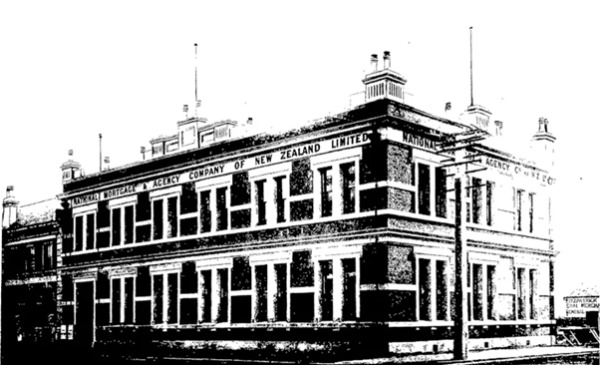
The building when it was the office of the National Mortgage and Agency Company.
As a historian, I’m particularly interested in the link between the National Mortgage and Agency Company and Trustees Executors – for my readers who are less interested in historical analysis, please feel free to skip ahead to the rest of the pictures!
Stock and station agents are a specific type of company which supports the agricultural community – in particular, they are the intermediary for the procurement of stock and other farm-related products. Stock and station agents are a rare example of a type of business which was/is unique to Australia and New Zealand. There has been significant scholarship within the field of history in recent years on the nature of the networks of empire. The traditional historiography (the technical term for academic work in the field of history) of Britain and its colonies placed London/England at the centre of the empire, with the colonies and other territories placed on the outer spokes of a metaphorical web.
Stock and station agencies are an excellent example for challenging this model. Stock and station agencies were a deeply integral part of the commercial and agricultural structure of both New Zealand and Australia in the 19th century (and earlier, in the case of Australia). They were an innovation of the colonies – and emphasis must be placed here on the fact that they were an innovation of the colonising peoples – which then fed back to Britain, in a reverse of the traditional understanding of ideas/wealth/power flowing outwards from the centre.
Trustee companies are another example of this. Trustees Executors, and the company on which it was modelled (the Trustees Executors and Agency Company, in Australia), had a unique and specific purpose within the context of the colonies. Trustee companies were founded on the ‘periphery’ of the British empire (the outer edges of the web), and the business model was then fed back to the heart of the Empire. I think it is relevant, then, that a building which was designed to be the office of a Stock and Station agency would then become instead the office of a trustee company.
Dunedin was still a new city in the 1880s. As mentioned earlier in this post, at this time Dunedin was the financial powerhouse of the country. It was in many ways also a centre of innovation, and its architecture reflects this. The National Mortgage and Agency Company participated in the innovation of colonial business through its existence as a stock and station agent. It’s importance to the local economy was indicated by the construction of a purpose-built office. The case of Trustees Executors is the same – it was a unique company, created for a uniquely New Zealand(/Australian) purpose, and the fact that it was able to take on its own premises in such a financially important city as Dunedin indicates that it was at the forefront of business innovation in New Zealand.
Incidentally, Trustees Executors came to occupy this building only after the National Mortgage and Agency Company began its game of musical premises with the Union Steamship Company (the founder of which was an original director of Trustees Executors).

The new National Mortgage and Agency Company Offices on the corner of Vogel and Water Streets, 1904. Now the Union Steamship Company building.
Otago Witness, 10 August 1904, https://digitalnz.org/records/14207488
The building that would, by 1906, be home to Trustees was designed by famous architect R.A. Lawson. Lawson was one of the most significant architects of early Dunedin, having designed notable landmarks such as the First Church, Larnach Castle, and Otago Boys High School. Lawson was a prolific architect, and there has been recent scholarship done to ascertain just how many structures in the city and surrounds Lawson was responsible for. 94 buildings he designed during his career are still standing in Dunedin – the Trustees Executors building among them.

View of Otago Boys' High School, Dunedin, ca 1925. Godber, Albert Percy, 1875-1949 :Collection of albums, prints and negatives. Ref: APG-0106-1/2-G. Alexander Turnbull Library, Wellington, New Zealand. /records/23228005
The office was remodelled from the original as depicted earlier in this post sometime around the 1930s, where it came to look a lot more like the building we are familiar with. Incidentally, the vaults were a part of the original design – the description of the building from the Otago Daily Times dated 11 November 1873 notes that “there are strong brick fireproof safes on each floor, and we notice that a proper lavatory and other conveniences have been provided for the offices.” I’m sure it comes as a great relief to all reading this today to know that original staff were surrounded by such luxury as indoor toilets!


The building changed very little after the 1930s – any member of staff from that era would have been at home in the office as it was last time I saw it in 2022.
The most interesting aspect of the building’s history, in my opinion, is that it exists at all. The former Dunedin office is a symbol of the innovation of Dunedin business at the height of the city’s wealth, and a symbol too of its longevity. The company exists as a part of the architectural fabric of the city, and its legacy will be felt as long as the building exists, despite the company no longer being based there.
Written by Beth Swanson
Trustees Executors